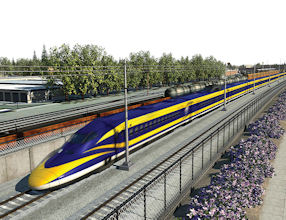Taxpayers in the San Fernando Valley have something in common with taxpayers in Portland, Maine when it comes to California’s High Speed Rail project: They are both paying for this $68 billion boondoggle. But why should taxpayers in either entity, and every one in-between, care? Critics of high speed rail have claimed for four years that the California High-Speed Rail Authority conducts its business through backroom deals carried out by executive personnel. Board meetings often seem to be shams. Inquiries from journalists in traditional news media go unanswered, and critics in new electronic media report hassles in getting records about controversial issues. One of the many examples of behind-the-scenes games involves a Project Labor Agreement, or PLA, that has been placed on the project. A PLA is a union monopoly agreement that contains provisions that force all construction workers to essentially become union for the duration of the job, such as having to pay into union pension plans they will never benefit from. PLAs are meant to discourage non-union firms from bidding. If they do bid and happen to win, then union pensions and political coffers get monies from non-union workers they otherwise would not have. The rail authority required the five pre-qualified prime contractors to sign this union agreement as a condition of winning the contract for the construction of the Madera to Fresno segment. The board never voted to negotiate or approve the PLA. It was developed and executed behind the scenes, probably to avoid public controversy. A cynic would suggest that the presence of the head of the State Building and Construction Trades Council of California, Bob Bagelnorth, on the rail authority board might have encouraged the PLA. Of course, union-affiliated organizations comprised seven of the top 10 donors, including the top five, to pass Proposition 1A in 2008, which gave the authority the ability to sell $10 billion in construction bonds. Meanwhile, the current CEO of the rail authority transferred to the job in 2012 from Parsons Brinckerhoff, the project management firm for the high-speed rail line. That company ranked sixth on the list of donors to the campaign to pass Proposition 1A. The latest underhanded, unaccountable action of the rail authority is the recommendation to award the prime contract for the Madera to Fresno segment to a company with the lowest technical score in the “best value” criteria for bidding. The bidding syndicate of Tutor Perini/Zachry/Parsons beat out other joint ventures, including companies with actual experience building high-speed rail projects. Based on the uproar from public agency representatives and California construction industry officials, Sylmar-based Tutor Perini Corp. has extensive experience in winning low bids and then submitting “change orders” during the project to get paid more money. Another partner, Parsons Corp., makes money administering union project labor agreements for large infrastructure projects in California, so it will be comfortable with the unionized construction work force on the high-speed rail project. But what is particularly outrageous about the apparent winning bidder is that the executive personnel for the rail authority changed the criteria for assessing the bidders during the two-stage process, without any public notice or board vote concerning the change. Technical experience as a weighted factor in the bid evaluations was supplanted with a new system that just happened to allow Tutor to get the best score among the five bidders. Incredible. In the meantime, critics of high-speed rail suspect that the four losing bidders felt compelled to avoid public complaining about the bidding process in order to get reimbursed up to $2 million each for the expense of preparing their losing bids. No one should be surprised that this project has developed into such an utterly corrupt, unaccountable and unpopular mess. It has been headed there from the start, which is why this issue is now awaiting a judge’s verdict thanks to the litigation brought forward by brave Central Valley farmers and land owners. This group went to court arguing that the measure approved by voters in 2008 authorizing $10 billion in construction bonds for the first phase of this project is not what is now being implemented. From cost estimates that have ballooned from $45 billion to $68 billion, to ridership and travel time projections that are simply not attainable, the project is not what we were promised. Backroom deals with union bosses? Secretive changes to the bidding process? A public body in charge of the most expensive project in American history that hides from the public? Promises made by supporters that have been abandoned? American taxpayers deserve better. Eric Christen is the executive director of the Coalition for Fair Employment in Construction, a trade group that represents non-union construction contractors.
